Appendix D
Qigong Practices
Whenever I begin a qigong class, we always ground and anchor into Wuji: we connect to our bodies (feet, legs, pelvis, stomach, spine, neck, head), our breath, our lower dan tian (or hara, just below the navel) and middle dan tian (heart), then we connect to the energies of Earth, then the Heavens, recognizing ourselves, with increased awareness, as an empty vessel between both.
Chapter 7 has a detailed description of how to settle into Wuji. This standing posture is both beneficial and meditative in its own right, a practice of surrender, of letting go to the energy flow. Once we are anchored into Wuji, we perform three warm-up exercises that are also taken from qigong. These are hip circles, spinal turns, and shaking. I include them here as I would not be without them, and I know them to be great for tension release and energy flow.
I close this section with a meditation that I think you will find very useful to include in the qigong practices that support the healing work in this book. I have posted other useful meditations on my website that I encourage you to include in your healing work.
Hip Circles
1. Depending on your gender:
– Ladies, bring your right hand to your stomach, palm facing into the lower dan tian (just below the navel), and place your left palm over the top of the right, palm facing inward.
– Gentlemen, bring your left hand to your stomach, palm facing into the lower dan tian, and place your right palm over the top of the left, palm facing inward.
2. Keeping your feet parallel and knees soft, begin to circle your hips around in an anticlockwise direction, slowly and gently, noticing the sensation, the smoothness, and the bumpiness of the hip as you circle. The body is engaged in a gentle spiral here, and movement begins to flow, releasing not only the hips but the knees, legs, and spine up to the nape of the neck. Make the movement as small or as big as feels good. Play, observe, and get to tune into and listen to what your body likes. We’re working with the Water element here, so perhaps imagine circling in a pool of water, or imagine the hip joint moving gracefully through the synovial fluid that surrounds it. This is a wonderful movement for anybody, but is particularly helpful if one’s work involves sitting for long periods throughout the day.
3. After about five minutes, follow a figure of eight (our infinity harmonizing shape) with the hips, to enable us to change direction and begin circling in a clockwise direction. Again, observe, allow, and observe again, bringing awareness into the body. Notice how the movement feels in this direction, and take time to unwind tensions and release. All of this time, energy is gathering in the lower dan tian through the alignment of two important energy points in the palms—the lao gongs and the lower dan tian (your deepest reservoir of resource). You might notice heat building in this area as energy begins to gather and move through the body as it spirals.
4. Once unwound, bring the circling movement back to the centre, back to stillness and the Wuji standing posture.
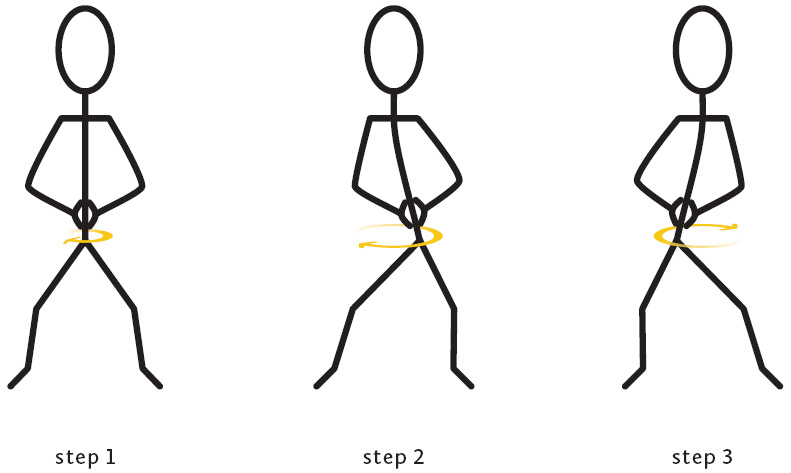
Hip Circles
Spinal Turns
Spinal turns offer us many benefits, including the release and movement of the spine from the sacrum all the way to the base of the skull. As we build momentum, the arms will begin to tap on the kidneys (liver, stomach, and spleen), which also bring great benefits. I actually moved into a past life regression and clearing from doing this movement at home.
The kidneys store old patterns and memories and are essential for the flow of our life force and feeling of vitality. When we carry holding patterns, especially in the shoulders—as most of us do—spinal turns can be a lovely practice to teach the body how to let this go, an active practice of surrender as we find freedom of movement within the body. Here’s how:
- Enter into Wuji, if you are not there already. Remember knees are soft and open, hips are loose, pelvis is neutrally hanging, feet are rooted, and there is a sense of rising through, or noticing the space in between the vertebrae in the spine.
- Turn the eyes and head slowly to face the left, then the right. Continue with this movement, allowing the shoulders to follow, sensing the movement and twist in the upper spine.
- Keeping the hips facing forward following the Wuji stance, begin to build speed and momentum with this practice, allowing the arms to hang loosely by the sides. The muscles of the arms and shoulders are as relaxed as possible.
- Reminding yourself to keep the knees softly bent and the hips facing forward, as if sitting on a horse, continue building momentum. When the hips are facing forward and not twisting with the movement, it allows the lower spine to twist. If we turn the hips, the lower spine remains still.
- As the momentum has built, it is as if we are swinging like a pendulum between the left and right. We can now allow the back of the hand to tap gently on the kidneys as we turn. The hand at the front of the body can fall onto the liver or stomach and spleen.
- Allow the head/eyes to turn as far as is comfortable for optimal spinal release.
- Bring the movement slowly into stillness.
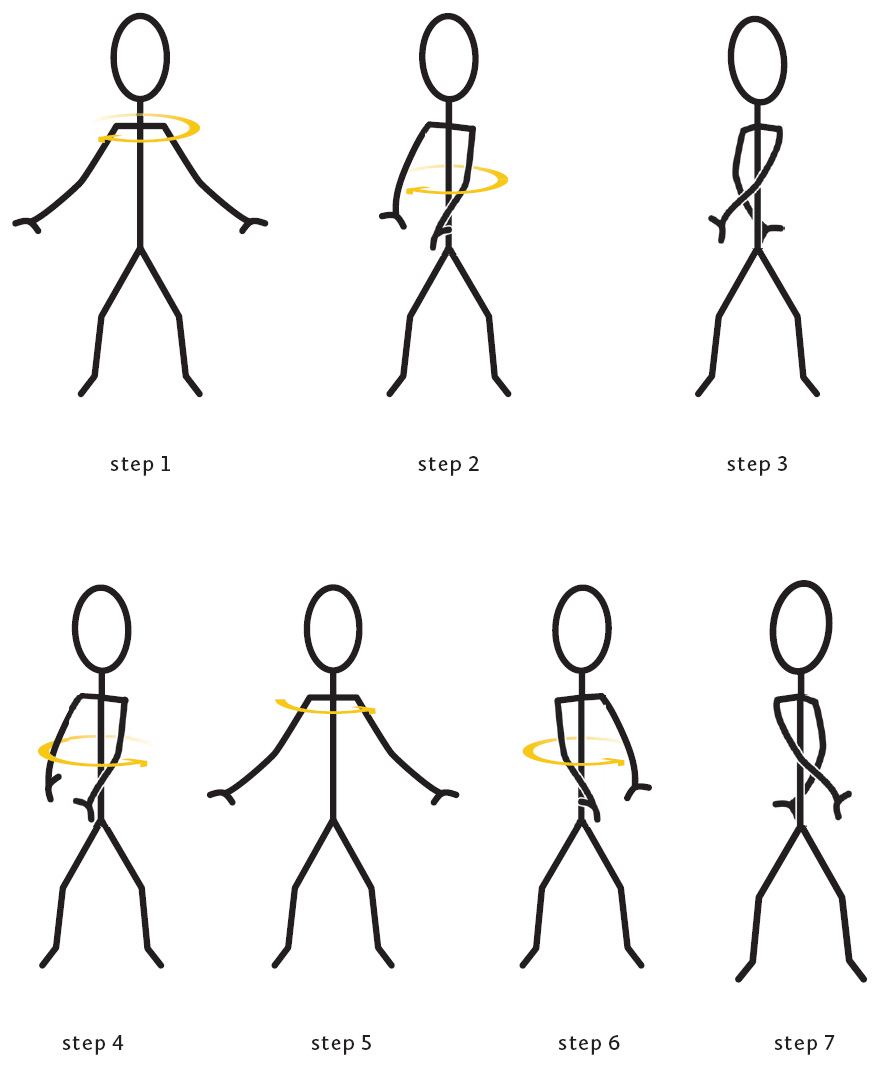
Spinal Turns 1-7
Shaking
The body loves to shake! When we can get past feeling self-conscious in class and give ourselves permission to shake, we feel the release and tension literally leaving our bodies and become aware of where we are holding tension. Shaking brings our awareness into the body and becomes quite a meditative practice. After a good shake, you may feel that it is time to move on, but the body may protest, as it needs more to come into stillness. Play with this one. There are huge benefits to shaking, including—so I was told by a yogi many moons ago—increased bone density.
- Begin in the Wuji standing posture, earthed and connected through the central channel to the heavens. Arms and shoulders are loose. All muscles are relaxed, including those of the jaw.
- Do a vertical shake, bouncing from the knees. I like to do this to music and enjoy Katie Hope’s Tai Chi album, track four, and Taylor Swift’s Shake It Off.
- Give yourself permission to shake it off, all of it, from anywhere you notice tension. Shake off down the arms and fingers, and through the legs and feet, into the earth.
- Gently come back to stillness, and kick off from the ankles and toes any remaining tension.
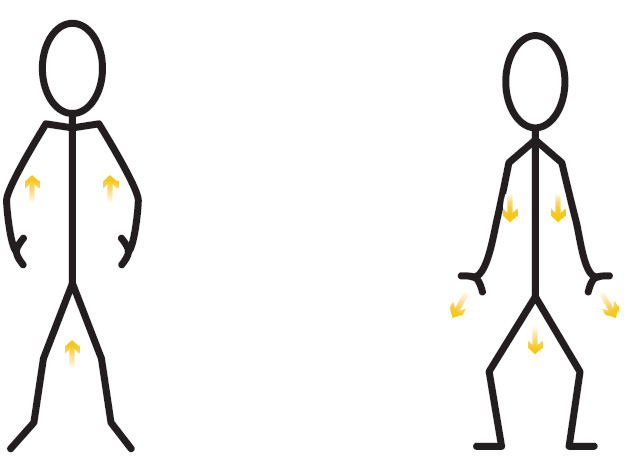
Shaking
Lung Openers
Lung openers are brilliant for regulating the breath. This is especially useful if meditation is something you struggle with. The breath is key to disrupting the fight-or-flight response, so if you find yourself in a fear or stress response frequently, lung openers are a lovely way to teach your body how to deepen and lengthen the breath without really focusing on it or trying to manipulate the breath into slowing down, which can sometimes cause anxiety. Proper breathing technique is vital for health. Many of us shallow-breathe and have stagnant air in the bottom of our lungs that doesn’t get emptied out. When the stomach is tight, the diaphragm rises, and we breathe into the top half of our lungs. When the stomach relaxes, and the air fully empties out, we can take in a full breath and fill our lungs. Go at your own pace with this one until you can slow down your breath in time with the movement. The exhale is key to a fresh new breath of qi. Here’s how it goes:
- Stand in Wuji, with your hands by your sides, and bring your index finger and thumb together.
- Breathe out. On the inhale, lead with your wrists, drawing the hands and finger and thumb (large intestine and lung meridians) up to the heavens. Allow your eyes and head to follow.
- Release the finger and thumb lock, so that the hands are soft and open, and allow the elbows and knees to soften. Your whole body begins to draw down towards the earth, returning to a slightly lower version of Wuji.
- Put your finger and thumb together again, and on the inhale, breathe in as you raise the arms, opening the lungs fully.
- Release the fingers, soften the hands, and draw the elbows and knees back down towards the earth as you fully exhale.
- Continue with this rise and fall, inhaling on the rise, arms extending upwards, and exhaling on the fall, muscles soft and relaxed.
- Exhale more fully than you think you can. This will allow you a full inhale.
- Begin to pause as you reach the heavens, perhaps imagining the moon and its silvery-white glow lighting up your lungs—as if for a moment, you are holding the moon between your hands.
- After several lung openers, come back into Wuji.
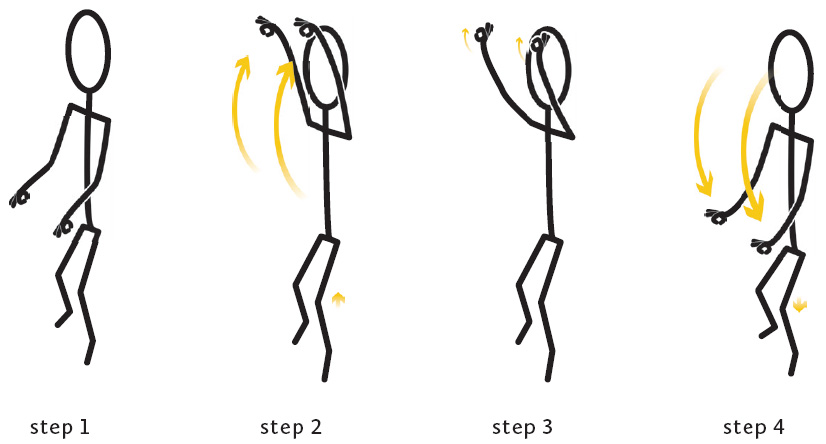
Lung Openers
Balancing Heaven and Earth
When we feel scattered, disjointed, and out of sorts, Balancing Heaven and Earth is a lovely way of bringing us back to a calm, gently energized place (as is the harmonizing infinity movement). This movement helps release excess energy and open the flow of energy through important meridians. We access more strength as we open the shoulder and the meridians that run from the hands, find a posture, and breathe for a short time as our bodies reconnect and balance the opposing yin and yang forces in our bodies and mind. We repeat this opening and balancing with the opposite hands, and so on.
- Stand in Wuji.
- Bring your hands into the Holding the Ball position in front of your lower dan tian (palms are beaming into the lower dan tian, sensing and sitting on the edge of its energy field). Stay here for a while, breathing qi into your lower dan tian, sensing your breath with your hands.
- Bring the left hand to the earthing position, palm facing the earth, hand sitting next to the lower hip. The energy pathway will then connect from the palm down the side of the leg to the earth. At the same time the right hand rises, palm facing the heavens, turning at the level of the face, until the back of the hand reaches and sits directly above the crown of the head, palm facing towards the heavens. The right arm is curved, the elbow soft. Remain in this position, and breathe for several steady breaths.
- Allow the top right hand to unfurl, bringing it slowly to briefly meet the left hand at the lower dan tian.
- Bring the right hand to the earthing position at the side of the hip, as the left hand rises, palm facing the heavens to begin with, turning at the level of the face until the arm lengthens and curves, with the palm facing the heavens and the arm extended directly above the crown. Remain in this position and breathe for several steady breaths.
- Continue alternating, one hand to the heavens, one to the earth, until you achieve a sense of balance.
- Draw arms towards the lower dan tian, and remain for a few minutes in the Holding the Ball position (palms beaming into and sitting on the periphery of the lower dan tian). Remain in this position, and breathe for several steady breaths.
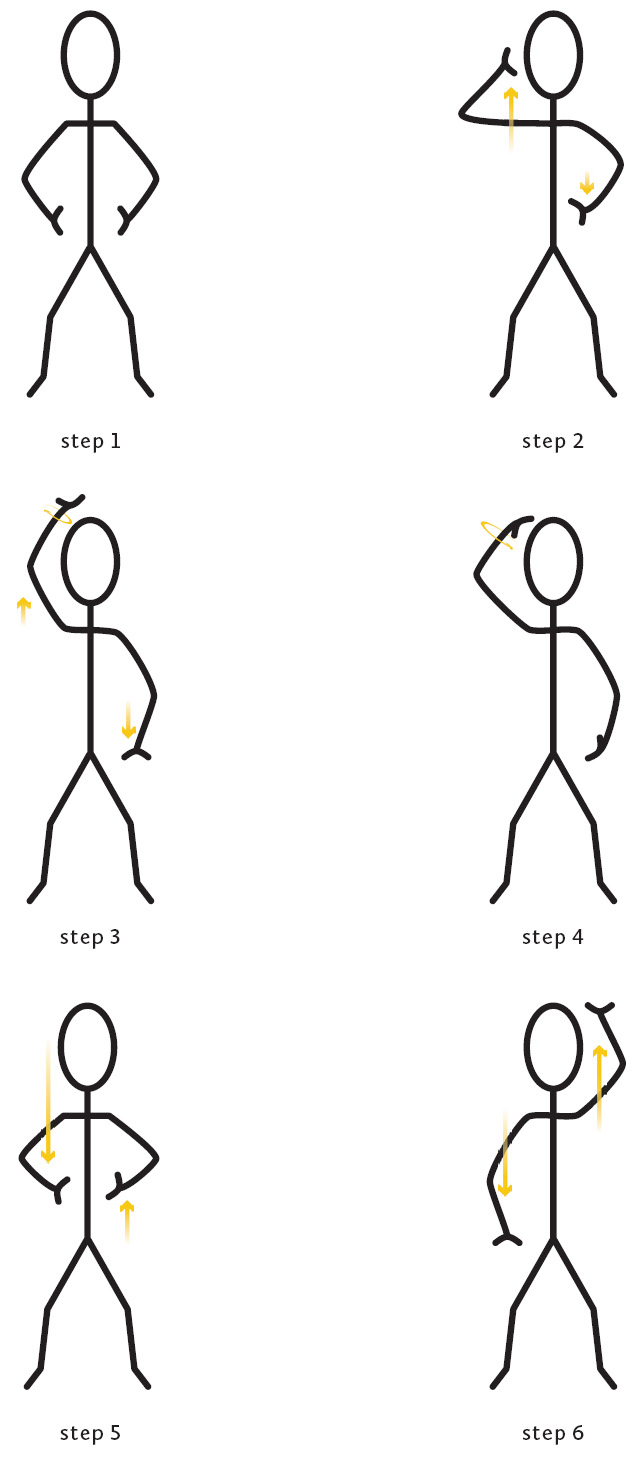
Balancing Heaven and Earth 1-6
- Bring both hands down to the earthing position, knees and shoulders soft and relaxed, to finish.
There are many more qigong movements I would love to share with you. I have posted some of these on the Healing InSight website. I recommend all of the above, plus the Crane for opening the heart and the Bone Marrow Cleanse, for boosting the immune system and supporting cell regeneration.
Meditation
Activating the Small Heavenly Circuit (Sometimes referred to as the Microcosmic Orbit)
The Small Heavenly Circuit meditation is a beautiful way to help bring energy flow back to the body through intention, attention, and breathwork. It activates the “superhighway” meridians (the Governing Vessel up the spine and the Conception Vessel down the front of the body), which helps increase energy, remove stagnation from certain areas in this circuit and transform the jing, or kidney essence, into qi, or energy flow, in the organ meridians. This is best practised after doing qigong gathering work in the lower dan tian, such as “holding the ball”. See diagram for the circuit.
- This meditation is best practised seated on a chair, but can be done standing.
- Place the tip of the tongue on the roof of the mouth. This connects the two vessels to enable the circulating orbit to generate and move energy.
- Imagine four balls of energy spinning in the lower dan tian, circling in a vertical manner, up the back, and down the front of this area, and allow this qi ball to expand or increase.
- Imagine and feel the moon spinning in orbit around the earth, and the earth spinning in orbit around the sun. Everything, from the cosmos to the electrons in our cells, is spinning in orbit. Place your own orbit within the larger orbits around you.
- As you breathe in, imagine a ball of qi travelling up the spine, over the top of the head, through the third eye, to the tip of the tongue.
- As you breathe out, imagine the ball of qi travelling down the front of your body to the perineum.
- With a gentle squeeze of the perineal muscles, direct the qi ball back up the spine again with the inward breath.
- Repeat this circular orbit nine or 18 times. Then change direction, starting with the ball of qi in the lower dan tian, connecting with the macrocosmic orbit of the sun, and breathing up the front and down the back, maintaining a tip-of-the-tongue connection and squeezing the perineum to help direct the energy flow.
- Optionally, add in a figure of eight orbit (the Large Heavenly Circuit) by following the ball of qi in the dan tian (up the back and down the front), then directing the energy flow in a figure of eight down the back of the legs to the feet/earth and back up the front of the legs to the perineum, up the spine, over the head, and down the front, down the back of the legs, and up the front of the legs to the perineum. Repeat nine or 18 times, then in the opposite direction nine or 18 times. This should help with energy coherence and health, create a vibrant field that helps protect against EMFs or outside energies, and boost energy levels!
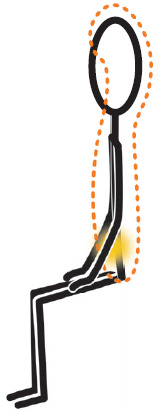
The Small Heavenly Circuit
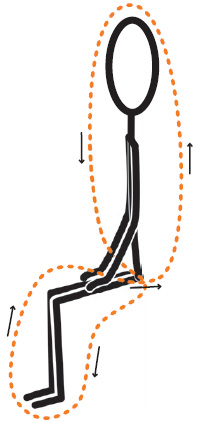
The Large Heavenly Circuit